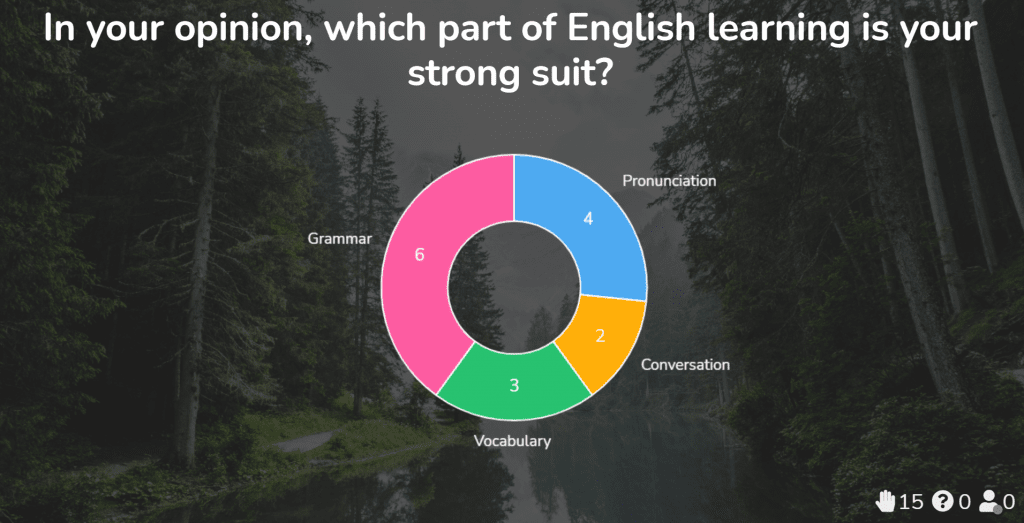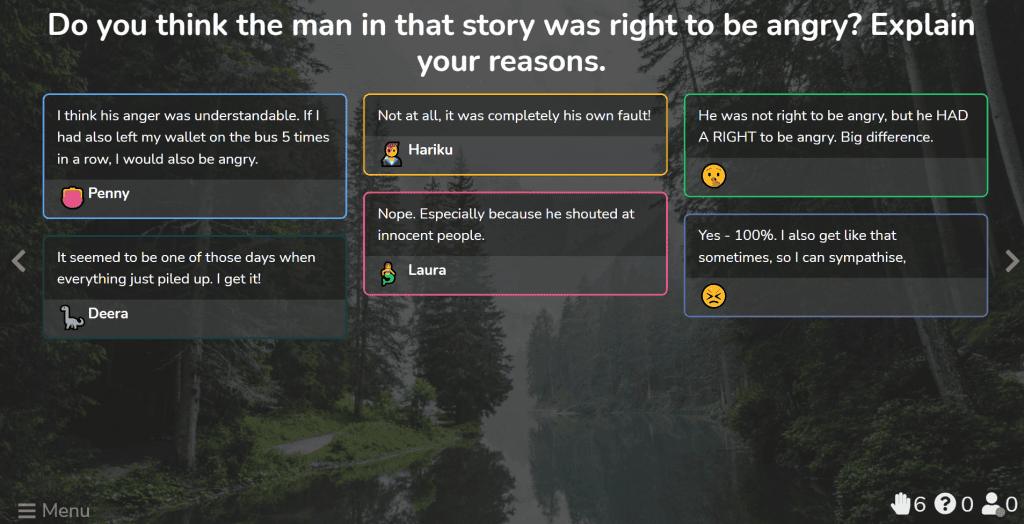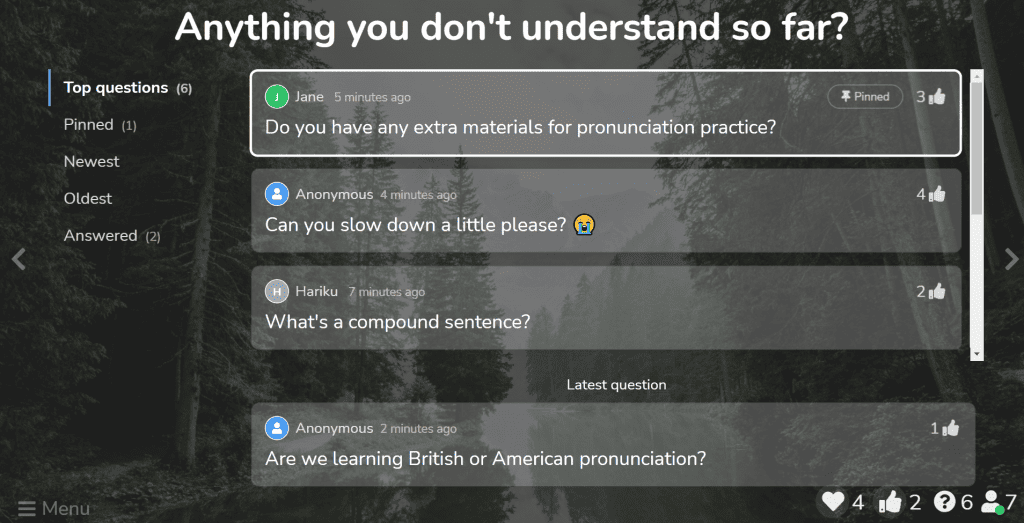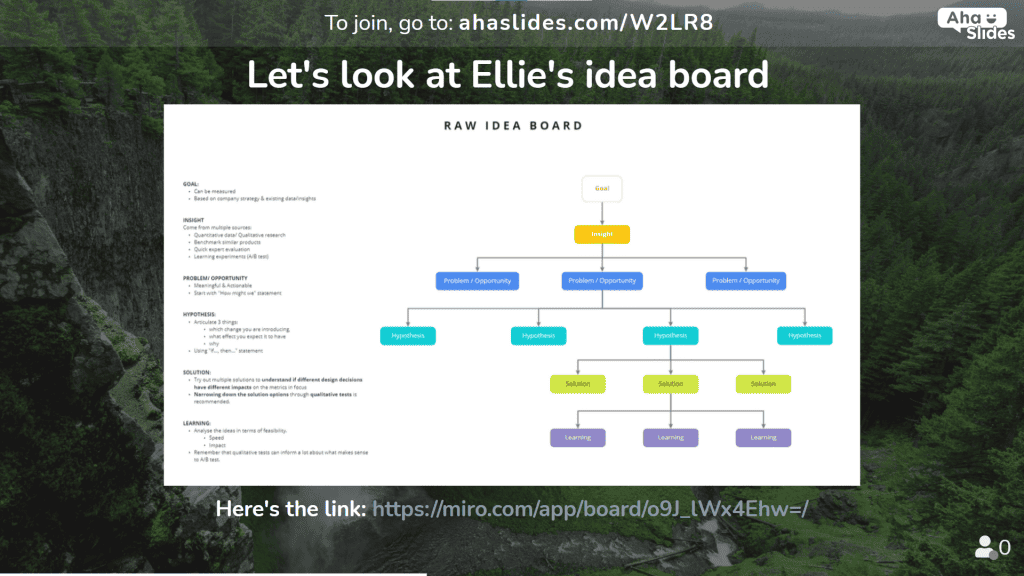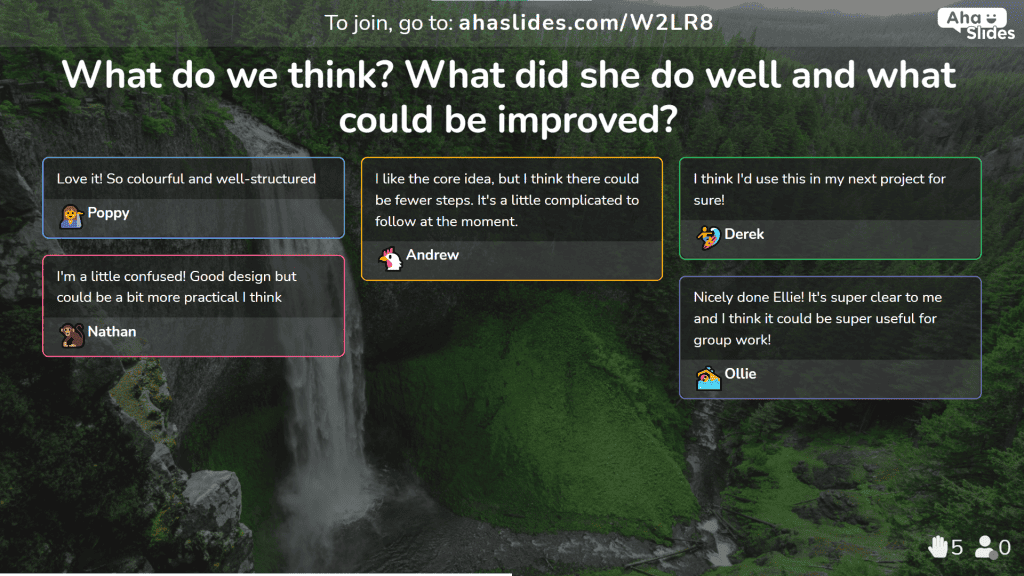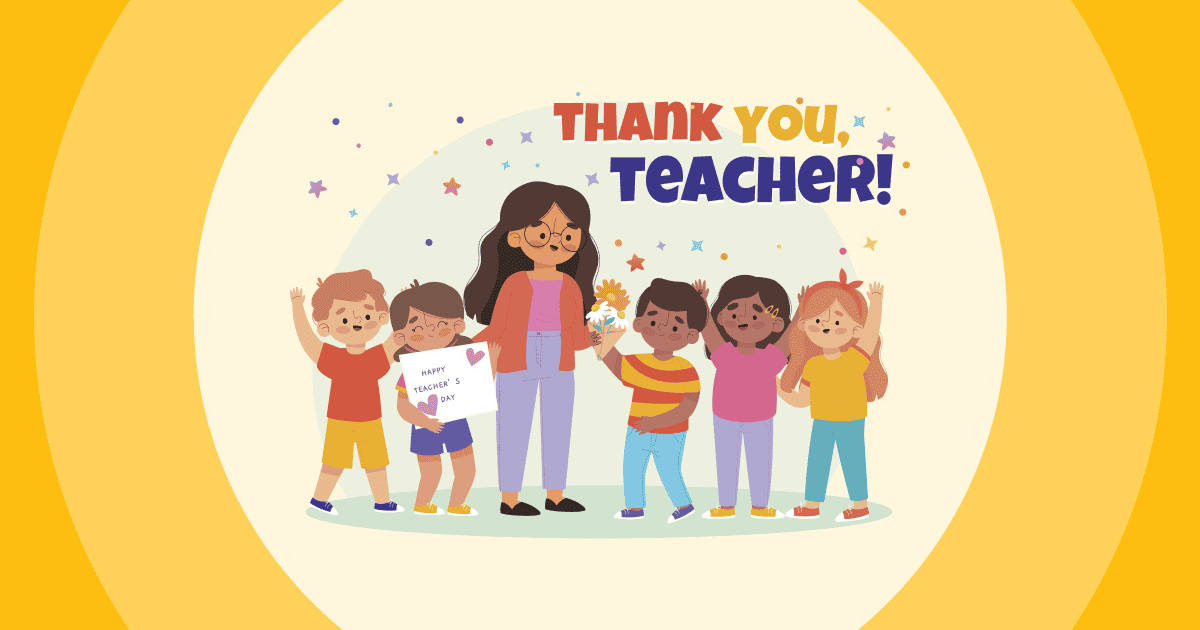우리는 늘 이런 말을 듣습니다. 훌륭한 교사는 훌륭한 동기 부여자입니다. 간단한 생각이지만, 교육자들이 수십 년 동안 고민해 온 개념에 기반을 두고 있습니다. 학생들에게 어떻게 동기를 부여합니까?
글쎄요, 의욕 저하가 의욕 저하를 낳습니다. 학생들에게 동기를 부여하지 못하면, 그들을 가르치도록 어떻게 동기를 부여 할 수 있습니까?
악순환이지만, 이를 극복하기 위한 12가지 팁 학생 교실 참여 일련의 대화형 교실 활동 아래는 부패를 막는 데 도움이 될 수 있습니다.
학생의 수업 참여도를 높이는 방법 – 가이드
- 학생 교실 참여가 중요한 이유는 무엇입니까?
- #1 – 학생 의견 활용
- #2 – 대화를 시작하세요
- #3 – 퀴즈를 통한 품종 경쟁
- #4 – Q&A 체크포인트 설정
- #5 – 가르치게 하세요
- #6 – 스타일을 섞어보세요
- #7 – 관련성을 높이세요
- #8 – 선택권을 주세요
- #9 – 기술을 수용하세요
- #10 – 대본을 뒤집으세요
- #11 – 갤러리 산책하기
- #12 – 그룹 활동을 절대 포기하지 마세요
AhaSlides를 활용한 더 많은 교실 관리 팁
- 교실 관리 전략
- 온라인 교실에서 학생 참여를 향상하는 방법
- 혁신적인 교수법
- 14년 학교 및 직장에서 브레인스토밍을 위한 2024가지 최고의 도구
- 아이디어보드 | 무료 온라인 브레인스토밍 도구
- 무작위 팀 생성기 | 2024년 랜덤 그룹 메이커 공개
학생 교실 참여가 중요한 이유는 무엇입니까?
참여도가 낮은 학생을 구제할 수 없다고 치부하거나, '학생 참여'를 시간적 여유가 있는 교사들을 위한 개념으로 치부하기 쉽습니다. 하지만 이 주제를 깊이 있게 다루면서, 여러분은 학생들에게 동기를 부여할 수 있는 동기를 보여주셨습니다. 그리고 그것이 바로 동기 부여입니다!
학생들의 학습 향상을 위한 올바른 발걸음을 내딛으셨습니다. 과제에 도움이 필요한 학생이라면 최고의 전문가에게 도움을 요청해 보세요. 수필 글쓰기 서비스. 이러한 서비스는 귀하의 작문 기술을 연마하고 학문적 노력의 성공을 보장하는 데 귀중한 지원을 제공할 수 있습니다.
- 미국 학생의 53 %는 엔가가 아니다제드 or 적극적으로 분리 수업에서. (갤럽)
- 2020 년도 말까지 1.3 만 명의 학생들이 참여를 중단했습니다. 원격 학습으로의 전환 때문에. (리마인드)
- 참여한 학생은 다음과 같은 결론을 내릴 가능성이 2.5 배 더 높습니다. 학교에서 우수한 성적. (갤럽)
학습 이탈은 만연하지만, 이를 막을 방법은 항상 존재합니다. 아래 팁은 오프라인이든 온라인이든 학생들의 타고난 학습 호기심을 되살리는 데 도움이 될 것입니다. 온라인 학습 학생 참여 기법.
4 가지 쉬운 승리
아래의 네 가지 기술은 가장 빠른 및 가장 쉬운 학생들의 관심을 사로잡는 방법입니다. 설정에 드는 노력이 거의 들지 않고 모든 수준의 학생들이 쉽게 이해할 수 있습니다.
#1 – 학생 의견 활용
여론조사는 여러분의 주제를 모든 젊은이의 우주의 중심인 자기 자신과 연결시켜주기 때문에 결정적입니다.
물론이죠. 그래도 그들에게 그들의 의견을 제공 자신의 의견이 주변 시스템에 어떻게 맞는지 보고, 놀라운 일을 할 수있다 학생 관심을 위해.
수업에 참여하는 목소리를 내면 많은 이점이 있지만 학생들에게 그들의 의견이 아니라 your 주제는 여기 쇼의 진정한 스타입니다.
ESL 수업에서 질문 할 수있는 아래 질문을 살펴보세요.
이 설문 조사는 다음과 같은 이유로 참여에 효과적입니다.
- 질문은 모두 그들.
- 학생들은 자신의 의견을 즉시 볼 수 있습니다. 다른 사람들과 쌓이다 그 주변.
- 교사인 당신은 이전에는 몰랐던 학생들의 모습에 대해 배울 수 있습니다.
확실하고 다양한 여론조사에 따르면, 전략 2번이 자연스럽게 다음 단계로 떠오르게 됩니다.
#2 – 대화를 시작하세요
여론조사보다 더 포괄적인 학습 참여 전략이 하나 있습니다. 본격적인 토론.
학생들이 설득력 있고 신중한 방식으로 자신의 미묘한 의견을 말하도록 하는 것은 교육의 궁극적인 꿈 중 하나입니다. 슬프게도 이 꿈은 교실에서 아무도 말하지 않는다 및 절대 혼돈.
Audiencegain과 이 기술이 존재하는 이유입니다.
많은 교육 기술 도구가 서면 답변 모든 사람이 자신의 목소리를 듣고 일을 유지하는 데 도움이되는 개방형 질문에 완전히 질서.
제출된 답변은 다른 모든 답변과 동등한 경쟁의 장에 들어갑니다. 칠판에 있는 동등하게 가치 있는 답변을 모두 순서대로 읽고 토론을 유도합니다.
그리고 수줍은 아이들? 익명으로 답변을 입력 할 수 있습니다.즉, 작성한 내용에 대한 판단에 대한 두려움이 없다는 뜻입니다. 자의식이 강한 학생들이 있는 모든 수업에서 실력 있는 학생들에게 익명 답변의 간편함은 참여를 크게 높일 수 있습니다.
더 많은 것을 읽고 싶습니까? 💡 전체 가이드가 있습니다. 학생 토론을 6 단계로 진행하는 방법!
#3 – 퀴즈를 통한 품종 경쟁
압도적인 경쟁의 힘은 교사에게 절대적인 금가루와 같다. 불행히도, 우연하고 궁극적으로 무의미한 별 보상 시스템을 제외하고, 학생 교실 참여 전략으로서의 경쟁은 여전히 많이 사용되지 않습니다.
어떤 관점을 가지고 있든, 경연대회는 교육에 많은 것을 제공할 수 있으며, 더 폭넓은 수용을 받아야 합니다.
Tom Verhoeff 박사, 아인트호벤 공과 대학.
성인이 되어서 우리가 자주 참여하는 가장 흥미로운 경쟁 유형 중 하나는 무엇일까요? 바로 저와 비슷하다면 라이브 퀴즈입니다. 제가 말하는 퀴즈는 시험이나 테스트를 의미하는 것이 아닙니다. 순위표, 재미, 드라마, 그리고 매우 열정적인 참가자들이 있는 좋은 퀴즈를 의미합니다.
혼자든 팀이든, 동료들과 경쟁하는 학생들의 쇄도는 참여의 회오리바람이 될 수 있습니다. 이해 관계가 높은 경우(즉, 상품이 좋은 경우) 퀴즈는 이 목록에서 가장 효과적인 학생 교실 참여 기술 중 하나가 될 수 있습니다.
다음은 훌륭한 교육 퀴즈를 만들기위한 몇 가지 팁입니다.
- 약 10 개의 질문으로 유지 – 학생들이 수업에 흥미를 느끼도록 하되, 지치지 않도록 주의하세요.
- 난이도 혼합 – 모두가 항상 경계하도록 하세요.
- 기술 사용 – 제 개인적인 경험으로는, 대규모 수업에서 펜과 종이로 하는 퀴즈는 관리하기 어렵습니다. 퀴즈를 다음과 같이 실행해 보세요. 전문 에듀테크 소프트웨어.
Protip 👊 여러 가지를 섞어보세요 스피너 휠. 다음과 같은 다양한 형식을 시도해 볼 수 있습니다. 백만 달러 경주, 또는 퀴즈 보너스로 사용하세요!
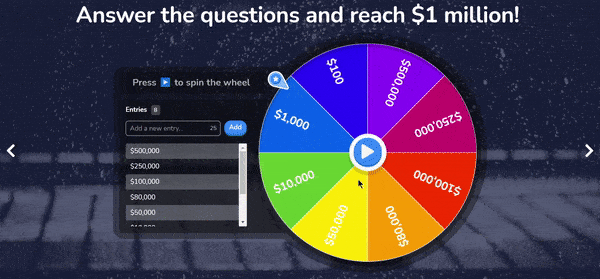
#4 – Q&A 체크포인트 설정
이탈의 가장 큰 원인 중 하나는 행동과 관련이 없으며 다음과 관련이 있습니다. 이해. 수업 내용의 질이 어떠하든, 학생들이 이해하지 못한다면, 선생님은 멍하니 앉아 있는 사람들로 가득한 강의실을 바라보게 될 겁니다.
물론, 당신은 그들에게 새로운 개념에 대한 당신의 설명을 이해하는지 물어볼 수 있지만, 일반적으로 자의식이 강한 학생들 중 얼마나 많은 사람들이 모든 사람 앞에서 따라가지 못한다고 인정할 것입니까?
에듀테크 시대의 답은 Q & A 체크 포인트. 효과가 있는 이유는 다음과 같습니다.
- 그들은 익명이에요 – 학생들은 익명을 보장받고, 두려움 없이 무엇이든 질문할 수 있습니다.
- 그것은 자세하다 – 학생들은 자신이 이해하지 못하는 부분을 신중하게 정리할 시간을 갖습니다.
- 그들은 조직적이다 – 모든 답변은 기록되어 있으며, 다양한 카테고리로 분류할 수 있으며 영구적으로 유지됩니다.
불을 붙이다 실제 학습.
위의 모든 기능을 무료로 사용해 보세요. 온라인 또는 오프라인 교실에서 인터랙티브하게 활용하세요!
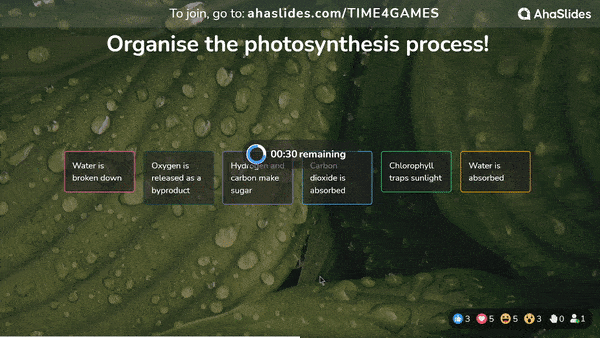
4 회 롱 플레이
이 네 가지 기술은 다소 장기적입니다. 이는 교육 방식에 작은 변화를 주는 것으로, 이해하고 설정하는 시간.
하지만, 일단 익숙해지면 이는 교실에서 사용할 수 있는 가장 매력적인 기술 중 하나가 될 수 있습니다.
#5 – 가르치게 하세요
교실 이탈의 비극 중 하나는 학교 과제의 85 % 더 높은 사고 능력을 허용하기에는 너무 경직되어 있습니다. 이것은 제한적인 강의 계획서보다 더 높게 생각하더라도 종종 수업을 흥미롭게 만듭니다.
이것은 교사 혼자서는 극복하기 어렵지만 학생들에게 주제의 일부를 가르치는 책임 환상적인 치료법입니다.

자신의 교사 교육으로 돌아가십시오. 행동 관리에 대한 교과서 연습을 할 때나 참관 실습 중에 젊은이들의 바다를 마주할 때 더 몰입했습니까? 어느 시점에서 더 높은 수준에서 생각하고 운영했습니까?
다음은 학생을 교사로 전환하는 몇 가지 팁입니다.
- 점차적으로하십시오. 이것이 학생들의 수업 참여를 위한 '장기적' 전략인 데에는 이유가 있습니다. 학생들은 무엇이든 가르치려면 시간과 연습이 필요합니다. 소규모 그룹일지라도 말입니다. 1년 내내 연습 시간을 분산하세요.
- 시간을 유지하십시오. 그들을 압도하지 않도록 그들에게 가르칠 수 있는 짧은 시간을 주십시오. 가르칠 때 시간이 가르치는 데 중요한 요소임을 이해하도록 시계를 주시하십시오.
- 기대치를 높이십시오. 학생들은 종종 방법 우리가 그들에게 공로를주는 것보다 더. 그들에게 도전을주고 그들이 그것을 만나는 것을 지켜보십시오.
#6 - 스타일 믹스
학습 스타일에 대한 다양한 접근 방식은 교사 교육의 기본입니다. 물론 우리는 그것들을 알고 있지만, 우리가 생각하는 만큼 우리는 호소합니다. 시각, 청각 및 운동 미학 학습자의 경우, 우리는 핵심 학생 그룹 중 적어도 하나에서 실패할 가능성이 있습니다.
운동 감각 학습자라면 매주 주어지는 형식적인 실습 활동 이상의 것이 필요합니다. 청각 학습자는 매 학기 두 번 이상의 토론이 필요합니다. 일관된 자극 수업에 계속 참여합니다.

모든 수업에 대해 다음 사항이 있는지 확인하세요. 각 학습 스타일에 대해 적어도 하나의 활동. 이것들은…일 수 있습니다.
- 개념 설명, 메모 작성, 비디오 시청, 퀴즈 풀기 – (시각적)
- 팟캐스트 듣기, 토론하기, 소리내어 읽기, 음악 만들기 – (귀의)
- 실험하기, 물리적인 것 만들기, 롤플레잉, 교실 돌아다니기 – (키네 미학)
기억하세요, 이건 꽤 힘들 수 있지만 그만한 가치가 있습니다. 수업이 예측 불가능해질수록 학생들의 수업 참여 시간이 길어질 것입니다.
Protip 👊 각 학생의 학습 스타일을 정의하세요 이 25 가지 질문.
#7 – 관련성을 높이세요
베트남에서 영어를 가르쳤을 때 모든 교과서가 영국이나 미국 문화만을 언급하고 있다는 것을 알게되었습니다. 에 따르면 국립 영어 교사 협의회 (NCTE), 베트남 학생들이 수업에서 그들의 문화와 관련된 것을 찾지 못했기 때문에 그들은 훨씬 더 신경을 쓰지 않을 것입니다.
문제는 문화에만 국한되지 않습니다. 수업 내용에 학생들이 공감할 만한 내용이 없다면, 굳이 그 주제를 배워야 할까요?
특히 십대 학생들의 경우 주제를 자신의 관심사와 관련된 내용과 연결하는 것이 다소 중요합니다.
이러한 관심사를 발견하는 것은 간단한 설문 조사. 90 년대 코네티컷 주 Interest-a-Lyzer라는 너무 길고 너무 먼 공립학교에서 90s 현대적인 용도로 사용할 수 있지만 질문은 설문조사에 사용할 수 있습니다. (이것은 좋은 쓰기 연습이라는 보너스도 있습니다!)
학생들에게 답변을 받으면, 학생들의 관심사를 중심으로 설명과 연습문제를 구성할 수 있습니다.
#8 – 선택권을 주세요
고학년 학생의 경우 모든 활동에 필요한 두 가지가 있습니다. 관련성(방금 논의한 내용)과 선택입니다.
학생들이 세상에서 길을 찾는 나이에,그의 선택은 모든 것이다. 교육은 학습자가 선택할 수 있는 경우가 거의 없지만 교실에서 선택권을 부여하면 학생의 동기 부여가 크게 증가할 수 있습니다.
다음은 선택 사항을 교실에 통합하는 몇 가지 방법입니다.
- 활동 – 연습으로 여러 가지 활동을 제공한 다음, 학생들이 선택하도록 합니다.
- Structure – 수업의 구조를 정하고 학생들이 어떻게 진행할지 선택하게 하세요.
- 장식 – 학생들에게 교실 배치에 대한 의견을 제시하게 하세요.
수업에 선택권을 천천히 도입하는 것이 가장 좋습니다. 대부분의 학생들은 학교에서, 그리고 어쩌면 삶에서도 선택권이 너무나 부족해서 교실에서는 어떻게 적용되는지 잘 모르는 경우가 많습니다.
더 많은 것을 읽고 싶습니까? 💡 체크 아웃 이 훌륭한 계정 교사가 선택권을 제공하여 학생의 집중력을 높인 방법.
온라인 학습용 4
온라인 학습은 점점 더 널리 보급되고 있지만, 학생들에게 원거리에 걸쳐 동기를 부여하는 것은 점점 더 어려워지고 있는 것 같습니다.
다음은 다른 것을 시도하기 위한 4가지 팁입니다. 원격 교실또는 당신은 할 수 여기에서 더 많은 것을 얻으십시오!
#9 – 기술을 수용하세요
2020년에 거의 모든 수업이 온라인으로 전환되었을 때, 교사들이 자신이 알고 있는 오프라인 수업 방식을 고수하는 경향은 이해할 만했습니다. 이러한 경향은 초기 단계에는 효과적이었지만, 지금은 그렇지 않을 것입니다.
풍부한 교육적, 창의적 및 협업 도구는 가상 교실에 혁명을 일으켰습니다. 코로나 바이러스의 새벽에 교사도 학생도 꿈도 꾸지 못했던 일을 할 수 있는 방법이 있습니다.

다음은 몇 가지 예입니다. 비어 있는 교사와 학생이 온라인 수업에서 사용할 수있는 도구 :
- 콘텐츠 X 알아보기 📊
학생들이 주제를 주관하고 창작할 수 있는 대화형 프레젠테이션 메이커 라이브 여론 조사, 온라인 퀴즈 그리고 그것에 대해 브레인스토밍을 합니다. 그것은 그 중 하나입니다. 혁신적인 교수법 교사들의 사회적 관계에서 흔히 볼 수 있는 이야기. - 컬러신치 📷
간단하지만 강력한 사진 편집 및 그래픽 디자인 소프트웨어입니다. Colorcinch에는 광범위한 벡터 그래픽, 스톡 사진 및 특수 효과 컬렉션이 있습니다. - Canva 🖌️
이미지, 포스터, 브로슈어, 팜플렛 등을 쉽게 제작할 수 있습니다. Canva에는 방대한 템플릿 라이브러리와 미리 제작된 요소가 있습니다. - 미로 🗒️
학생들이 브레인스토밍하는 데 사용할 수 있는 공동 화이트보드는 동시에 서로 생각하는 프로세스와 디자인 솔루션을 보여줍니다. - 플립그리드 📹
교사가 질문을하고 학생들의 비디오 응답을받을 수있는 비디오 플랫폼입니다.
특정 연령대의 학생들은 기술에 대한 선천적인 호기심을 가지고 있기 때문에, 기술을 적극적으로 활용하는 것은 학습 참여도를 높이는 좋은 전략이 될 수 있습니다. 하지만 과하게 활용하지 않도록 주의해야 합니다. 한 번에 너무 많은 새로운 도구를 접하면 학생들의 학습 주의를 산만하게 할 수 있습니다.
#10 – 대본을 뒤집으세요
'플립러닝' 학생들이 집에서 개념을 배우고, 수업 시간에 배운 개념과 관련된 문제를 적극적으로 토론하고 해결하는 것을 말합니다. 일반적인 학교 숙제와 다른 점이라고 생각하면 됩니다.
학업과 숙제가 같은 책상에서 이루어지는 원격 학교 세계에서 뒤집힌 학습은 동기 작업 (실시간 교사와 함께)과 비동기 작업 (실시간 교사가 없음)의 역할을 바꾸는 것입니다.
원격 교육에서 플립러닝 혁명이 일어날 것이라는 증거는 많습니다. 가장 고무적인 통계 중 하나는 Flipped Learning Network의 설문 조사 – 이 방법을 시도한 교사의 80%가 다음과 같이 보고했습니다. 학생 동기 향상.
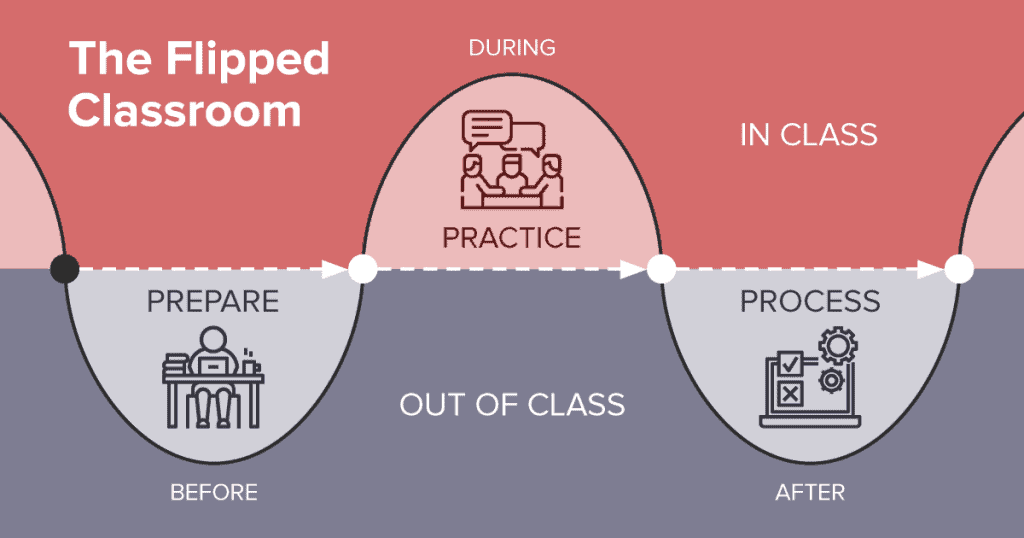
이유가 무엇일까요? 학생 참여를 높이기위한 뒤집힌 학습의 이점을 확인하십시오.
- 수업에서 학생들은 참여할 수 있습니다. 자신의 속도로. 능력이 낮거나 높은 학생들은 자신에게 적합한 수준의 작업에 집중할 수 있습니다.
- 더 보기 자치 그리고 학생들이 공부에 대한 소유권을 가질 수 있다는 것은 학생들이 스스로 주도권을 가질 수 있다는 것을 의미하는데, 이는 매우 큰 동기 부여 요인입니다.
- 뒤집힌 학습은 학생들에게 할 일 정보를 수동적으로 수집하는 사람으로 취급하지 않습니다. 이렇게 하면 수업이 하루 종일 다른 표준 수업과 차별화되고 학생들이 참여할 수 있습니다.
한번 해보고 싶나요? 다음 온라인 수업에서 이것을 시도해 보세요:
- 수업 전 : 학생들을위한 주제 자료 (비디오, 팟 캐스트, 녹화 된 강의, 읽기 자료 등)의 공유 폴더를 만들고 각 자료를 진행하도록 지시하십시오.
- 수업 시작시 : 학생들에게 주제에 대한 이해도를 측정하는 간단한 퀴즈를 제공 한 다음 각 학생을 이해 수준별로 그룹화합니다.
- 수업 중 : 각 그룹에 자극적인 활동(토론, 협력, 문제 해결)을 제공하여 이해를 강화합니다.
더 읽고 싶으세요? 💡 이 체크 아웃 뒤집힌 학습에 대한 훌륭한 소개 레슬리 대학교
#11 – 갤러리 산책하기
내 작품이 동료들에게 공개된다는 걸 안다면 얼마나 더 동기 부여가 될까요? 아마 꽤 많이요. 바로 그것이 갤러리 워크의 아이디어입니다.
갤러리 워크는 학생들의 작품을 서로에게 보여주는 슬라이드쇼입니다. 학생들은 작품을 감상하면서 관찰하고 작품에 대한 자신의 느낌을 적습니다.
이 활동이 학생과 교실의 참여를 높이는 좋은 활동인 이유는 다음과 같습니다.
- 증가합니다 학생 동기 고유 한 경쟁 감각을 통해
- 증가합니다 학생 초점 관련 없는 사람이 아닌 동료의 작품을 보기 때문입니다.
- 증가합니다 학생의 자유 항상 동기 부여에 긍정적입니다.
귀하의 갤러리 산책은 설정이 매우 간단합니다. 아래와 같이 댓글을 적을 수 있는 공간이 있는 프레젠테이션을 만드세요.
#12 – 그룹 활동을 절대 포기하지 마세요
원격 학습으로의 대대적인 마이그레이션에서 중단된 모든 학습 형식 중에서 가장 큰 피해는 그룹 작업이었습니다.
학생들이 필요로 할 때 사회적 상호 작용 및 협력 대부분의 교사들은 모둠 활동을 온라인 수업으로 옮기는 것은 불가능하다고 생각했습니다. 학생들은 '학습' 시간의 대부분을 반 친구들과 완전히 고립된 느낌으로 보냈습니다.
이는 학습자 동기에 심각한 타격을 줍니다.. 여기에 몇 가지 그룹 작업 팁이 있습니다.
- Google 드라이브와 같은 파일 공유 소프트웨어에 대한 액세스 권한을 부여합니다.
- Trello와 같은 칸반 보드 (작업 할당) 소프트웨어에 대한 액세스 권한을 부여합니다.
- Zoom 및 기타 화상 통화 소프트웨어에서 '분과 회의'를 사용하여 실제 그룹 작업을 시뮬레이션하세요.
- 대규모 프로젝트를 여러 개의 작은 작업으로 나누어 그룹으로 완료합니다.
자주 묻는 질문들 (FAQ)
교실에서 학생 참여를 어떻게 측정합니까?
교실에서 학생 참여도를 정량적, 질적으로 측정하는 방법은 다음과 같이 다양합니다.
– 관찰 척도 – 교사는 활동적인 참여, 눈 맞춤, 일정 간격으로 질문하는 것과 같은 과제 수행 행동을 객관적으로 기록합니다.
– 과제 수행 시간 – 학생들이 수업 활동에 적극적으로 참여하는 총 시간과 과제를 수행하지 않는 총 시간의 비율을 추적합니다.
– 학생 자체 보고 – 설문 조사는 주의, 가치, 수업의 즐거움에 대한 질문을 통해 인지적, 행동적, 정서적 참여를 측정합니다.
– 숙제/과제 – 독립적인 작업의 질과 완료도를 평가하면 개인 참여에 대한 통찰력을 얻을 수 있습니다.
– 참여 기록 – 손을 든 횟수, 토론 참여 횟수 등의 기록 빈도를 기록합니다.
– 시험 점수/성적 – 학업 성취도는 참여도와 연관이 있지만, 참여도만으로 결정되는 것은 아닙니다.
– 교사 평가 척도 – 설문지를 통해 교사는 학급/학생 참여 수준을 질적으로 평가합니다.
– 비공식적인 확인 – 스캐폴딩 질문에 대한 응답, 업무 관련 대화 주제 등입니다.
수업 참여의 이점은 무엇입니까?
더 적극적으로 참여하는 학생들은 더 나은 시험 점수, 프로젝트 품질 및 학습 유지를 보여줍니다. 참여형 수업은 학습을 더욱 즐겁게 만들고 학생들에게 주인의식을 부여하여 내재적 동기를 부여합니다.


